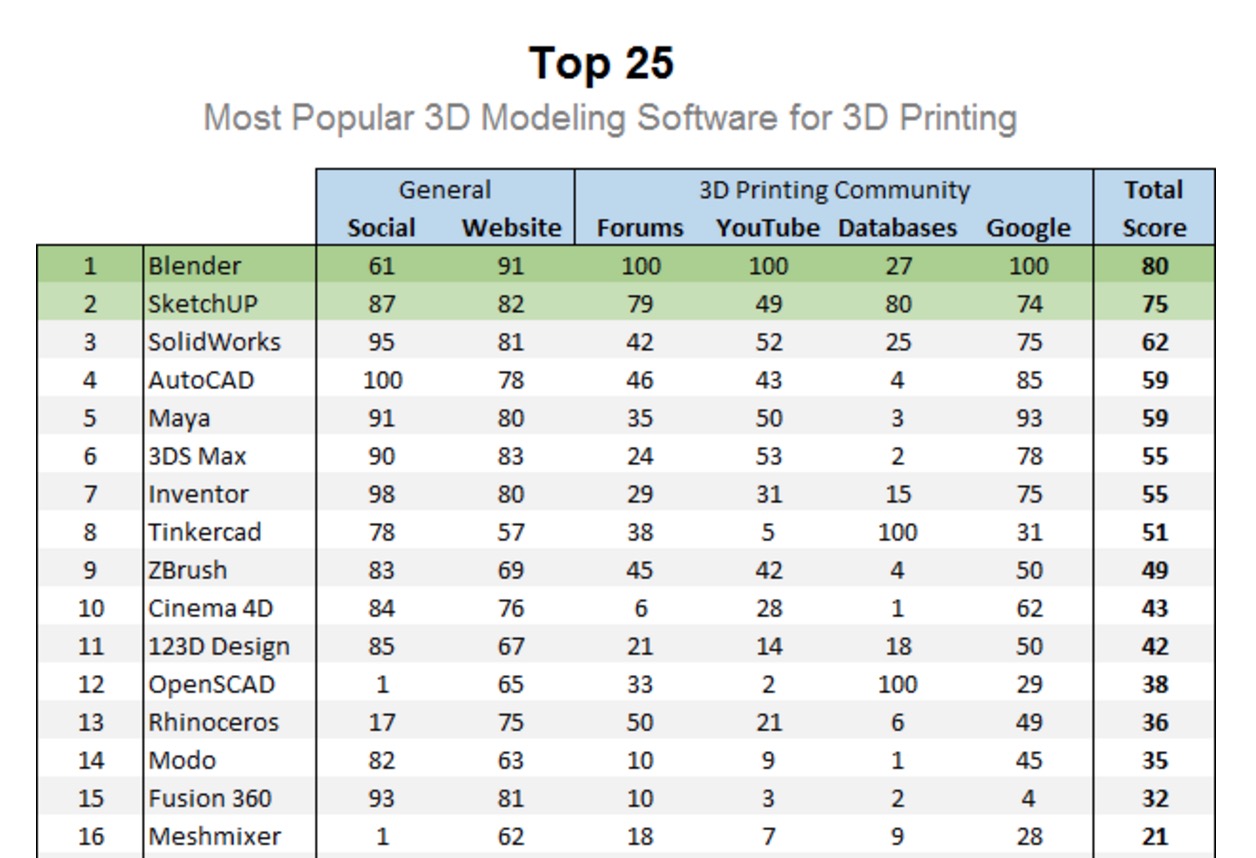
i.materialise published a handy list of what they believe to be the most popular 3D modeling software packages, but we have some questions.
The question of “which 3D software should I use?” is a very frequent question in our experience. It seems that when people want to “get into 3D printing”, they then find out they need to perform 3D design with appropriate software, hence the question.
But the question is loaded with ambiguity, as there are more factors than one might suspect when choosing 3D software. But first, let’s look at what i.materialise did.
Their top 25 list of the “most popular 3D modeling software for 3D printing” is as follows:
- Blender
- SketchUp
- SolidWorks
- AutoCAD
- Maya
- 3DS Max
- Inventor
- Tinkercad
- ZBrush
- Cinema 4D
- 123D Design
- OpenSCAD
- Rhino3D
- Modo
- Fusion 360
- Mesh mixer
- LightWave
- Sculptris
- Grasshopper
- FreeCAD
- MoI3D
- 3Dtin
- Wings3D
- K-3D
- BRL-CAD
You might think, “aha, let’s pick one from the top of the list I can afford”, but there’s more to it than just that. Here are some other considerations you might contemplate beyond popularity and price (which, by the way, is incredibly important, since the prices of these products range from literally zero to tens of thousands per seat, depending on options selected).
Design Focus: The key question is, “Is this software engineered to design the kind of 3D models I will be creating?” It turns out that the design features in each tool are good for some things but not others. For example, if you are designing machine parts, you probably want to look at SolidWorks, Inventor or BRL-CAD. If you are designing freeform sculptures, perhaps you should look at Sculptris or ZBrush.
Prior Knowledge: This is perhaps the deepest consideration of all. Ask yourself the question, “Do I already know how to use this 3D software?” If the answer is yes, maybe you should go no further, since to become proficient at many of these choices, you must spend considerable time learning how each tool works.
Software Capability: The tools on i.materialise’s list vary considerably in capability. Some might be considered “junior” or “introductory” tools, while others are full-on professional tools. Decide what level of capability you require and filter appropriately.
Design Function: There are many pure design tools on the list, but some are actually not design tools per se. MeshMixer, for example, is a hugely useful tool, but for modifications of existing 3D models, and not so much for creating them from scratch. Grasshopper is a plug-in for Rhino3D that is used to mathematically generate 3D shapes, and not a full design tool on its own.
Platform: Not all of these tools will work on your computer, if it isn’t Windows. Some offer version for Linux and OS/X, and there may even be web-based options on the list. Before selecting one, make certain you can actually run the software!
Popularity: Just because a tool is popular doesn’t mean it is the most appropriate item for you. Sure, the popularity likely indicates there are plenty of user forum posts you can browse for assistance, but what about new tools that haven’t been around long? One we can think of is Onshape, a very powerful web-based 3D design tool that can match up with most of the items on the list. Because it’s new, it does not yet appear on this list of top 25.
Regardless of your situation (finance, knowledge and purpose) there most certainly is a 3D software tool that fits. Take the time to investigate each and choose wisely.
One method that might help you out with this choice is our own 3D software buying guide that provides an interactive way to select a 3D design tool based on your answers to basic questions of intent.
Via i.materialise

